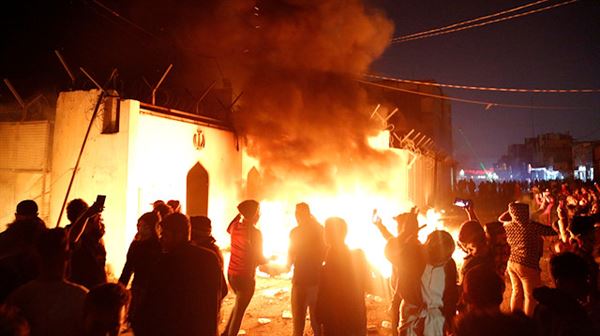Following the U.S. invasion of Iraq in 2003, the Iranian influence has expanded in the country through intervention in the formation of political part
Following the U.S. invasion of Iraq in 2003, the Iranian influence has expanded in the country through intervention in the formation of political parties, and supporting militia groups.
It was not that easy for an Iraqi in the past to criticize Iran or to tear up the Iranian flag or photos of Ayatollah Ruhollah Khomeini, Iran’s spiritual leader of the 1979 Islamic revolution, and Supreme Leader Ali Khamenei, which are prevalent in public squares across southern Iraqi provinces.
Protests that started in Basra province in July of last year reflected for the first time the state of anger against the Iraqi government dominated and ruled by pro-Iran Shia parties, as well as against militia groups such as the pro-government Hashd al-Shaabi paramilitary force and other Shia armed militia groups.
During the anti-government protests in Shia-dominated areas, protesters raised slogans in Persian and Arabic, expressing their rejection for their country to be subordinate to Iran.
The protesters at several occasions expressed their anger and rejection to the Iran’s stance regarding the Iraqi protests.
They burned the photo of Qasem Soleimani, the commander of the Revolutionary Guards’ Quds Forces. They also burned the Iranian consulates in Najaf and Basra as well as offices of political parties allied with Iran in central and southern Iraq.
Some reports suggest that Soleimani visited Iraq three times since the start of mass protests in Iraq early October. Some analysts view his visit as a support to the Iraqi officials to discuss how to suppress the protests.
Iranian authorities and leaders of the Revolutionary Guards accuse the U.S., Saudi Arabia and Israel of being behind the protests to sabotage the relations between Iraq and Iran.
What angers the Iraqi protesters is the Iranian support for the government of outgoing Prime Minister Adel Abdul-Mahdi and allied parties and militias and Tehran’s call for Abdul-Mahdi not to resign.
As the protesters expressed their rejection to any external interference whether from the U.S. or from Iran, the outrage towards the Iranian influence in the Shia-dominated areas has been more striking.
On Nov. 18, U.S. media published reports by Iran’s Intelligence Ministry that demonstrated the scale of Iranian interference in the economic, political, military, security and religious affairs in Iraq.
One of the leaked reports say that Abdul-Mahdi has maintained a “special relationship” with Iran since he was an oil minister in 2014.
The protesters see that over 16 years of ruling Iraq by officials and political parties allied with Iran, the country has drowned in corruption, becoming on the top of the most corrupt countries in the world, according to international transparency organizations.
The Iraqi people are also disappointed by the Iraqi consecutive governments since the fall of Saddam regime, which failed to address the poor living conditions.
The Iraqi protesters demand an improvement of the living conditions, and a profound political reform to get rid of external interferences in Iraqi politics as in Iran’s support for Abdul-Mahdi not to resign.
Abdul-Mahdi, however, had to resign on Nov. 30 under the pressure of the protests.
Protesters set fire to the offices of the Islamic Dawa Party — led by former Prime Minister Nuri al-Maliki — in southern Nasiriyah and Diwaniyah cities. Vehicles and offices of Hashd al-Shaabi, Badr Organization and al-Hikma (National Wisdom) party were damaged and burned as well.
The Iranian statements on the Iraqi protests have fueled sentiment against Iran, which was clearly expressed in the slogans of the protesters.
At several occasions, some Iranian officials implicitly said Iran views Iraq as a gate to export its revolutionary ideas and to enhance its influence over the areas that could connect Iran to the Mediterranean sea through the shores of Syria and Lebanon.
Iran fears that in case the protests in Iraq expands, Iraq will enter a state of chaos and instability, which could make it harder to keep or preserve the Iranian influence and interests in the country. Iran would then lose a strategic depth in addition to losing the high volume of business and trade with Iraq.
Iran also uses Iraq to bypass the U.S. sanctions, which negatively affect the Iranian economy — also one of the reasons for the protests in Iran.
There is for sure a change in the Iraqi Shia public attitude towards officials and political parties allied with or backed by Iran including a change in their view towards the Iranian regime.
According to the protesters, there is a strong relation between getting rid of the Iranian influence and of the Iran-backed militia groups and political parties which they think both usurped Iraq’s power and resources.
These feelings of anger against Iran’s interference in Iraq could pave the way for founding new common grounds for a trans-sectarian awareness with the Iraqi Sunni population, who rejects any kind of Iranian influence.
